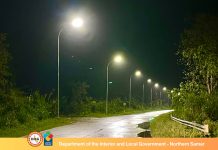
TACLOBAN CITY — Catbalogan City Mayor Dexter Uy personally led relief and assessment operations in areas heavily affected by Super Typhoon ‘Uwan’, assuring residents that the city government will extend all necessary support to help them recover.
Accompanied by City Administrator Dennis Cosmod, City Health Officer Dr. Anna Sophia R. Lim, and personnel from the Office of the City Mayor, Mayor Uy visited several affected barangays to check on the condition of displaced families and assess the extent of the damage.
The team also inspected landslide-hit areas in Barangay Guinsorongan and surveyed destroyed properties and homes in other affected communities. They later visited evacuees temporarily housed at the Samar National School to ensure their safety and well-being, including affected students.
According to the City Disaster Risk Reduction and Management Office (CDRRMO), more than 1,103 families or about 4,209 individuals evacuated to safer grounds before and during the onslaught of Uwan.
Authorities also confirmed one casualty—a 64-year-old woman from Pier 2, Barangay 3—whose house collapsed when strong winds and waves struck the shoreline.
Mayor Uy said that the city government has already sought assistance from national agencies for families who lost their homes and for students whose classes were disrupted by the typhoon.
He likewise appealed to residents who were spared by the disaster to share what they can—such as food, clothing, or other essentials—to help families currently staying in evacuation centers.
“Puede la anay hira didto. Tatalinguhaon naton nga mas mag-iha hira ha mga evacuation center kay an mga eskwelahan gagamiton na,” Uy said, noting that evacuees will remain temporarily sheltered while recovery efforts are ongoing.
The mayor also advised residents whose homes were destroyed along the coast to refrain from rebuilding in high-risk areas, stressing that returning to the shoreline would only expose them to future dangers during calamities.
(ROEL T. AMAZONA)



